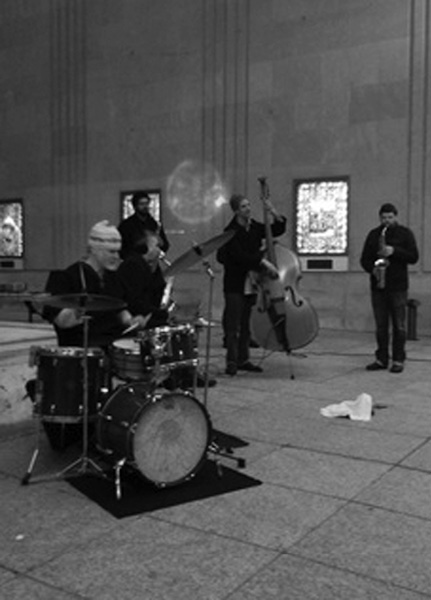
SUNSET WITH MIRO’S CHICAGO
first performed on October 4, 2014
In front of Miró’s Chicago, Chicago, IL
performed once in 2014
SOUND ENSEMBLE / JON GODSTON, BRYAN PARDO, JOSH BEATTY, SPENCER HUTCHINSON, DAN GODSTON, BONBONFERA TIM KEENAN, DAN MCNAUGHTON
Chicago, IL
940674414d940674414a940674414n940674414@940674414b940674414o940674414r940674414d940674414e940674414r940674414b940674414e940674414n940674414d940674414.940674414o940674414r940674414g
borderbend.org/blog/miro-sunset
SUNSET WITH MIRO’S CHICAGO
SOUND ENSEMBLE / JON GODSTON, BRYAN PARDO, JOSH BEATTY, SPENCER HUTCHINSON, DAN GODSTON, BONBONFERA TIM KEENAN, DAN MCNAUGHTON
“Sunset with Miró’s Chicago” occurred in the plaza-alcove where the Miró’s Chicago is found; part of the performance also took place on the Chicago Picasso. This performance event—which included sound, movement and projections of NASA photos of the sun and moon—was presented in collaboration with the Chicago Temple. The Sculpture Ensemble members included Josh Beatty (tenor saxophone), Bryan Pardo (alto saxophone, clarinet), Jon Godston (soprano saxophone), Spencer Hutchinson (alto saxophone), Dan Godston (trumpet), Bonbonfera Tim Keenan (percussion) and Dan McNaughton (upright bass). This performance happened during the Ninth Annual Chicago Calling Arts Festival and in collaboration with the Chicago Temple, which gave us permission to perform in front of Miró’s Chicago.
During one segment of the performance several Sound Ensemble members performed in front of the Miró sculpture, whereas several others performed on the Picasso sculpture (which has a slanted piece of steel that the public is encouraged to climb on). The improvised sounds of the ensemble members intermingled with the urban sunset and crepuscular din.
During this performance we were interested in exploring interrelationships between how performers improvise with each other, while doing so in a site-specific way as inspired by looking at the surrounding public art and projections of NASA photos. We also wanted to know what would happen to the sounds coming from the musical instruments as the physical locations of the musical instruments changed (from alcove, to open plaza, to having a saxophone horn face down on an urban avenue). We were also interested in messing with the sonic, visual and movement categories and boundaries that often become codified and ritualized in urban spaces. For instance, since part of the performance happened on both the south and north sides of Washington Street, this was an opportunity to question ways by which streets and the vehicles that use those streets often divide and cut off potential civic and creative activities that could happen in urban areas.